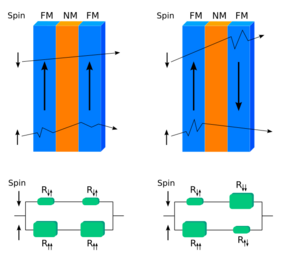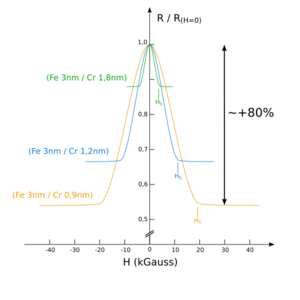Giant magnetoresistance facts for kids
Giant magnetoresistance (GMR) is a cool effect where a material's electrical resistance changes a lot when a magnetic field is applied. It's like a special switch that uses magnetism to control electricity! This effect is super important for reading and writing information in computer hard drives.
The GMR effect was discovered by two scientists, Albert Fert and Peter Grünberg. They even won the Nobel Prize in Physics in 2007 for their amazing discovery.
Contents
How GMR Was Discovered
The GMR effect was first found in 1988. Peter Grünberg and his team at the Jülich Research Centre in Germany discovered it. They were working with very thin layers of iron and chromium.
Around the same time, Albert Fert and his group at the University of Paris-Sud in France also found the GMR effect. They saw a really big change in resistance, which is why they called it "Giant" magnetoresistance. Fert's team was also the first to explain how this effect actually works.
This discovery was a huge step forward and started a whole new field of science called spintronics. Both Grünberg and Fert received many awards, including the Nobel Prize, for their work.
Different Kinds of GMR
There are a few ways the GMR effect can show up in materials.
Multilayer GMR
Imagine stacking super-thin sandwiches! In multilayer GMR, you have two or more magnetic layers, like iron, separated by a very thin non-magnetic layer, like chromium. These layers are only about 1 nanometer thick – that's super tiny!
When these layers are just the right thickness, it becomes easy to change how strong the magnetism is between them. This change in magnetism can make the electrical current flowing through the layers change by up to 10%! The first time GMR was seen, it was in stacks with 10 or more of these layers.
Spin Valve GMR
Spin valve GMR is similar to multilayer GMR, but it usually has just two magnetic layers separated by a thin non-magnetic layer (about 3 nanometers thick). This setup allows scientists to control the magnetism between the layers very precisely.
Scientists are always researching how the "spin" of electrons can make these spin valves even better. Materials like copper and a mix of nickel and iron are often used in spin valves.
Spin valve GMR is the most useful type for things like hard drives. It's carefully tested to make sure it meets high industry standards.
Granular GMR
Granular GMR is a bit different. It's found in materials like copper that have tiny grains of cobalt mixed in. With granular GMR, it's not as easy to control the magnetic strength as it is with multilayer or spin valve GMR.
What GMR Is Used For
GMR is a key technology in many modern devices.
- Hard Drives: The biggest use of GMR is in modern hard drives. GMR sensors are used to read the tiny magnetic bits of information stored on the hard drive's platters.
- Magnetic Sensors: GMR is also used in other types of magnetic sensors. These sensors can detect magnetic fields for various applications.
- MRAM: Another exciting use is in magnetoresistive random access memory (MRAM). This is a new type of computer memory that uses magnetism to store data, making it very fast and energy-efficient.
The discovery of GMR truly kicked off the new field of spintronics, which explores how to use the spin of electrons, not just their charge, in electronics.
Related pages
Images for kids
See also
 In Spanish: Magnetorresistencia gigante para niños
In Spanish: Magnetorresistencia gigante para niños




